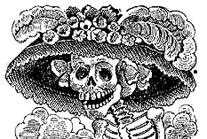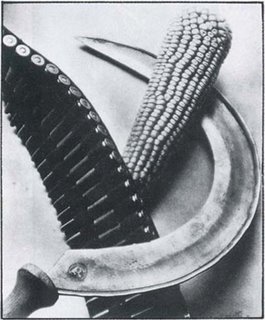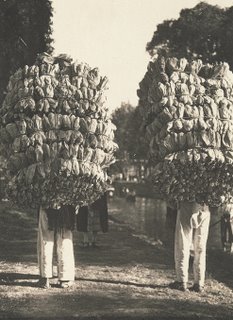
Σημερινές φωτογραφίες από την συγκέντρωση πρεσβεία του Μεξικό. 
Posted by...Unknown at 10:10 μ.μ. 7 comments
OAXAKA - ΑΥΡΙΟ ΤΡΙΤΗ ΣΤΙΣ 6 ΤΟ ΑΠΟΓΕΥΜΑ
Δευτέρα, Οκτωβρίου 30, 2006
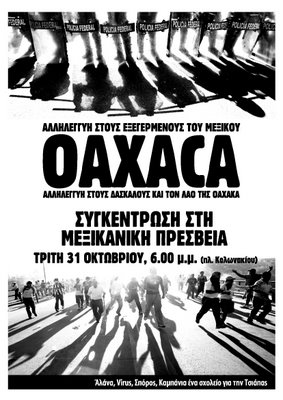
ΑΛΛΗΛΕΓΓΥΗ ΣΤΟΥΣ ΕΞΕΓΕΡΜΕΝΟΥΣ ΤΟΥ ΜΕΞΙΚΟΥ
ΑΛΛΗΛΕΓΓΥΗ ΣΤΟΥΣ ΔΑΣΚΑΛΟΥΣ ΚΑΙ ΤΟ ΛΑΟ ΤΗΣ ΟΑΧΑΚΑ
Την Κυριακή 29 Οκτωβρίου η ομοσπονδιακή αστυνομία του Μεξικού εισέβαλε στην πόλη της Οαχάκα και έπνιξε στο αίμα την εξέγερση των δασκάλων και του λαού της, που πέντε μήνες τώρα αγωνίζονται για μια εκπαίδευση με αξιοπρέπεια και για δικαιοσύνη. 4.500 χιλιάδες πάνοπλοι ομοσπονδιακοί αστυνομικοί, υποστηριζόμενοι από ελικόπτερα που έριχναν δακρυγόνα επί ώρες, τεθωρακισμένα οχήματα και πυροσβεστικά οχήματα, κατέλαβαν την πόλη. Στους 12 νεκρούς που μετράει ο αγώνας των δασκάλων από τον Ιούνιο, προστέθηκαν τουλάχιστον δύο ακόμα. Υπάρχει άγνωστος αριθμός συλληφθέντων και εξαφανισμένων και φόβος και για άλλους νεκρούς. Στο Μεξικό των «από κάτω», στο Μεξικό που αγωνίζεται ήρθε να προστεθεί άλλο ένα βάρβαρο χτύπημα.
Ο αγώνας των δασκάλων της Οαχάκα ξεκίνησε με απεργία στις 22 Μάη και με αιτήματα την αύξηση των πενιχρών μισθών τους και την καλυτέρευση των άθλιων συνθηκών στα σχολεία. Μετά τη βίαιη καταστολή από την πολιτειακή κυβέρνηση στις 14 Ιουνίου, στον αγώνα των 70.000 δασκάλων προστέθηκαν πάνω από 350 κοινωνικές, ιθαγενικές οργανώσεις, σωματεία, συνδικάτα, μη κυβερνητικές οργανώσεις, και σχημάτισαν τη Συνέλευση των Λαών της Οαχάκα (ΑPPΟ), με κύριο αίτημα την παραίτηση του κυβερνήτη της πολιτείας, Ουλίσες Ρουίς.
Η ομοσπονδιακή κυβέρνηση του Μεξικού, επέλεξε το δρόμο της άγριας καταστολής αντί να ακούσει τα αιτήματα ενός ολόκληρου λαού. Ο λαός της Οαχάκα αντιστέκεται στους δρόμους της πόλης και ζητάει την αλληλεγγύη μας.
Εμείς που υπογράφουμε αυτό το γράμμα, δάσκαλοι, καθηγητές, φοιτητές, οργανώσεις, σωματεία, συλλογικότητες και πολίτες από την Ελλάδα δηλώνουμε και διαδηλώνουμε την αλληλεγγύη μας στους δασκάλους και τον λαό της Οαχάκα!
ΦΤΑΝΕΙ ΠΙΑ με την καταστολή των αγώνων. ΦΤΑΝΕΙ ΠΙΑ με τη βία των κυβερνήσεων και των κατασταλτικών μηχανισμών. Είναι σημαντικό να κινητοποιηθούμε σε όλο τον κόσμο ενάντια στην ποινικοποίηση των αγώνων μας, ενάντια στη βία των κυβερνήσεων. Η καταστολή ενάντια στον λαό της Οαχάκα είναι καταστολή και ενάντια στους δικούς μας αγώνες.
Η καρδιά μας βρίσκεται στους δρόμους της Οαχάκα, στο πλευρό των δασκάλων και του λαού της που αντιστέκεται, η καρδιά μας βρίσκεται όπου υπάρχει αγώνας για ΑΞΙΟΠΡΕΠΕΙΑ!
Συνυπογράφουμε το αίτημα της Συνέλευσης των Λαών της Οαχάκα να παραιτηθεί ο κυβερνήτης Ουλίσες Ρουίς και απαιτούμε:
Να αποσυρθεί η ομοσπονδιακή αστυνομία από την πόλη της Οαχάκα
Να σταματήσει η καταστολή
Να απελευθερωθούν όλοι οι κρατούμενοι
Να αποδοθεί δικαιοσύνη για τις δολοφονίες
Posted by...unapatatras at 9:36 μ.μ. 15 comments
Συναγερμός OAXACA! Ακτιβιστές στην Μεξικάνικη πρεσβεία της Ζυρίχης (30-12-2006)
 Μόλις έλαβα το Newsletter από τους Ελβετούς ακτιβιστές της οργάνωσης "Direkte Solidarität mit Chiapas" (βλ. και στα links Chiapas για γερμανομαθείς) και σας μεταφέρω ότι σήμερα το πρωί στις 11:15, 50 ακτιβιστές διαφορετικών οργανώσεων υπεράσπισης των ανθρωπίνων δικαιωμάτων διαδηλώσανε μπροστά από την μεξικάνικη πρεσβεία στη Ζυρίχη την αντίθεσή τους στα αίσχη της μεξικανικής κυβέρνησης και την αποστροφή τους στα έκτροπά της στην Oaxaca αποδίδοντας στο τέλος ένα ψήφισμα διαμαρτυρίας στον πρέσβη.
Μόλις έλαβα το Newsletter από τους Ελβετούς ακτιβιστές της οργάνωσης "Direkte Solidarität mit Chiapas" (βλ. και στα links Chiapas για γερμανομαθείς) και σας μεταφέρω ότι σήμερα το πρωί στις 11:15, 50 ακτιβιστές διαφορετικών οργανώσεων υπεράσπισης των ανθρωπίνων δικαιωμάτων διαδηλώσανε μπροστά από την μεξικάνικη πρεσβεία στη Ζυρίχη την αντίθεσή τους στα αίσχη της μεξικανικής κυβέρνησης και την αποστροφή τους στα έκτροπά της στην Oaxaca αποδίδοντας στο τέλος ένα ψήφισμα διαμαρτυρίας στον πρέσβη.
 Η κατάσταση στην Oaxaca είναι τόσο σοβαρή που εγκυμονεί πολλούς κινδύνους για την ζωή, την σωματική και ψυχική υγεία των κατοίκων της αλλά και για την αξία των ανθρωπίνων δικαιωμάτων γενικότερα. Εκατοντάδες χιλιάδες ανθρώπων πολεμούν εδώ και 5 μήνες για τον εκθρονισμό της διεφθαρμένης κυβέρνησης του PRI και του Ulises Ruiz, την βελτίωση του εκπαιδευτικού συστήματος όπως επίσης και για γενικότερες μεταρρυθμίσεις όσον αφορά στα ανθρώπινα δικαιώματα.
Η κατάσταση στην Oaxaca είναι τόσο σοβαρή που εγκυμονεί πολλούς κινδύνους για την ζωή, την σωματική και ψυχική υγεία των κατοίκων της αλλά και για την αξία των ανθρωπίνων δικαιωμάτων γενικότερα. Εκατοντάδες χιλιάδες ανθρώπων πολεμούν εδώ και 5 μήνες για τον εκθρονισμό της διεφθαρμένης κυβέρνησης του PRI και του Ulises Ruiz, την βελτίωση του εκπαιδευτικού συστήματος όπως επίσης και για γενικότερες μεταρρυθμίσεις όσον αφορά στα ανθρώπινα δικαιώματα. Μαζί με τα δύο θύματα της περασμένης νύχτας, οι νεκροί φτάνουν τους 15. Όλοι δολοφονήθηκαν από παραστρατιωτικές οργανώσεις ή από δυνάμεις της αστυνομίας. Οι άνθρωποι που έχασαν την ζωή τους χθες βράδυ, δολοφονήθηκαν εν ψυχρώ από την PFP (Policia Federal Preventiva). Οι 4000 βαριά οπλισμένοι άντρες της κυβέρνησης Fox υποστηρίζονται παρασκηνιακά από τουλάχιστον άλλους τόσους. Πολλά ελικόπτερα, οχήματα εκτόξευσης νερού και τεθωρακισμένα βρίσκονται σε ετοιμότητα.
Μαζί με τα δύο θύματα της περασμένης νύχτας, οι νεκροί φτάνουν τους 15. Όλοι δολοφονήθηκαν από παραστρατιωτικές οργανώσεις ή από δυνάμεις της αστυνομίας. Οι άνθρωποι που έχασαν την ζωή τους χθες βράδυ, δολοφονήθηκαν εν ψυχρώ από την PFP (Policia Federal Preventiva). Οι 4000 βαριά οπλισμένοι άντρες της κυβέρνησης Fox υποστηρίζονται παρασκηνιακά από τουλάχιστον άλλους τόσους. Πολλά ελικόπτερα, οχήματα εκτόξευσης νερού και τεθωρακισμένα βρίσκονται σε ετοιμότητα. Απαίτηση των Ακτιβιστών είναι:
Απαίτηση των Ακτιβιστών είναι:-Ο τερματισμός των επιθέσεων απέναντι στον λαό της Oaxaca.
-Αναζήτηση ευθυνών μέσα στις στρατιωτικές και αστυνομικές μονάδες και επίρριψη νομικών κυρώσεων στους υπεύθυνους για τα έκτροπα.
-Τερματισμός των οδομαχιών χωρίς τη χρήση βίας. Κάθε προσπάθεια βίαιης εκκένωσης των οδοφραγμάτων θα οδηγήσει σε λουτρό αίματος.
-πολιτική λύση των συγκρούσεων στην Oaxaca και καθαίρεση της παράνομης κυβέρνησης του Ulises Ruiz Ortiz.
A los integrantes de la APPO
Al pueblo en resistencia de Oaxaca y en todo México
Zurich, Suiza, 30 de Octubre 2006
Muy estimad@s compañeras y compañeros en lucha
Hoy día a las 11 de la mañana marchamos 60 personas al frente del consulado Méxicano en Zurich, Suiza para protestar contra la represión masiva del Gobierno Federal de Vicente Fox y de Ulises Ruiz, el Gobernador de Oaxaca, que ya cayó! Dejamos una carta de protesta y gritamos en frente del consulado “Ruiz Asesino” y cantamos por fin la cancion “El Pueblo unido jamás será vencido”.
Vemos esta protesta como un otro paso a las protestas que seguirán y vamos a darlo todo para marchar adelante.
Estaremos atentos a lo que va a pasar y estamos convencidos de que los pueblos de Oaxaca y de todo México luchando con dignidad, van a encontrar seguidamente caminos para avanzar mas adelante hasta un mañana justo, libre y democrático!
Les mandamos nuestros saludos solidarios y fraternales.
Abrazos y Fuerza!
Posted by...Erwtas Stomaxhs at 7:44 μ.μ. 7 comments
οαχάκα - ιούλιος 2006 από το αρχείο
Posted by...unapatatras at 6:00 μ.μ. 0 comments
Τα ξύλινα τείχη
Κυριακή, Οκτωβρίου 29, 2006
 Έναν τοίχο όσο δυνατά κι αν τον κτυπήσεις δεν θα τον μεταμορφώσεις ποτέ σε πόρτα. Ο αποκλεισμός κι η απομόνωση πολεμούνται μόνο με το γκρέμισμα του. Αυτό τουλάχιστον έδειξε το παράδειγμα του τείχους του Βερολίνου που για 28 χρόνια αποτέλεσε σύμβολο μιας ολόκληρης εποχής, αυτής του Ψυχρού Πολέμου. To 2002 το Ισραήλ προχώρησε στην ανέγερση ενός άλλου τείχους κατα μήκος των ψευδοσυνόρων του με τα παλαιστηνιακα εδάφη με το πρόσχημα της προστασίας του από τρομοκρατικές επιθέσεις. Στις 26 Οκτωβρίου η απόφαση για την επέκταση ενός τρίτου τείχου, αυτη τη φορά στα σύνορα Ηνωμένων Πολιτειών και Μεξικου κλείνει την τριπλετα των σύγχρονων τειχών της ντροπής.
Έναν τοίχο όσο δυνατά κι αν τον κτυπήσεις δεν θα τον μεταμορφώσεις ποτέ σε πόρτα. Ο αποκλεισμός κι η απομόνωση πολεμούνται μόνο με το γκρέμισμα του. Αυτό τουλάχιστον έδειξε το παράδειγμα του τείχους του Βερολίνου που για 28 χρόνια αποτέλεσε σύμβολο μιας ολόκληρης εποχής, αυτής του Ψυχρού Πολέμου. To 2002 το Ισραήλ προχώρησε στην ανέγερση ενός άλλου τείχους κατα μήκος των ψευδοσυνόρων του με τα παλαιστηνιακα εδάφη με το πρόσχημα της προστασίας του από τρομοκρατικές επιθέσεις. Στις 26 Οκτωβρίου η απόφαση για την επέκταση ενός τρίτου τείχου, αυτη τη φορά στα σύνορα Ηνωμένων Πολιτειών και Μεξικου κλείνει την τριπλετα των σύγχρονων τειχών της ντροπής.Το ιστορικό του τείχους αυτού ξεκινα τον Νεομβριο του 2005, όταν ο Duncan Hunter πρότεινε στη Γερουσία την κατασκευή ενός τείχους μήκους 1.125 χιλιομέτρων κατά μήκος των συνόρων Ηνωμένων Πολιτειών και Μεξικού, προκειμένου να αντιμετωπιστεί το ακανθώδες για την αμερικανική πλευρά πρόβλημα της λαθρομετανάστευσης από τον νότο. Τον Δεκέμβρη του 2005, η πρόταση υπερψηφίστηκε στην Βουλή των Αντιπροσώπων και τον Μάη του 2006 η Αμερικανικη Γερουσία έδωσε το πράσινο φως για την ανέγερση των πρώτων 370 μιλίων.
Πριν 3 μερες, στις 26 Οκτωβρίου, και κατά την προεκλογικη περίοδο για την ανάδειξη των νέων μελών του Κονγκρεσου, ο George Bush με μια κίνηση που στόχο έχει περισσότερο να κατευθύνει την ατζέντα των θεμάτων της προεκλογικής εκστρατείας σε θέματα ασφάλειας παρά την προσεκτική και ψύχραιμη αντιμετώπιση του προβλήματος των οικονομικών μεταναστών, υπέγραψε την απόφαση Η.6061 για την επέκταση του μήκους του τείχους στα 1.125 χιλιόμετρα. Το κόστος του έργου που εν τέλει θα στοιχίσει περί τα 1,2 δις δολάρια και η ανάθεσή του σε κατασκευατική εταιρεία με έντονη δραστηριότητα στην ανοικοδόμηση του Ιρακ είναι μια άλλη ενδιαφέρουσα πτυχή του θέματος, όχι ωστόσο η πιο σημαντική του.
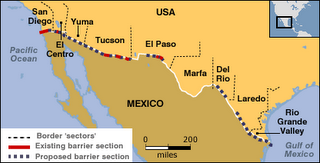 Η κυβέρνηση του Μεξικού που ήδη από το Μάιο είχε αντιδράσει στην απόφαση του Κονγκρεσου και με έμμεσο τρόπο ενισχύσει τις πορείες και λοιπές ενδηλώσεις διαμαρτυρίας σε αμερικανικές πόλεις τον Ιούνιο, εκδήλωσε μέσω του νέου προέδρου Καλντερόν την αντίθεσή της σε μια τέτοια ενέργεια, καλώντας την Αμερική να μην προχωρήσει στην υλοποίηση της απόφασής της. Αντ' αυτου πρότεινε να προχωρήσουν οι δύο χώρες σε ουσιαστικό διάλογο για ζητήματα μεταναστευτικής πολιτικής.
Η κυβέρνηση του Μεξικού που ήδη από το Μάιο είχε αντιδράσει στην απόφαση του Κονγκρεσου και με έμμεσο τρόπο ενισχύσει τις πορείες και λοιπές ενδηλώσεις διαμαρτυρίας σε αμερικανικές πόλεις τον Ιούνιο, εκδήλωσε μέσω του νέου προέδρου Καλντερόν την αντίθεσή της σε μια τέτοια ενέργεια, καλώντας την Αμερική να μην προχωρήσει στην υλοποίηση της απόφασής της. Αντ' αυτου πρότεινε να προχωρήσουν οι δύο χώρες σε ουσιαστικό διάλογο για ζητήματα μεταναστευτικής πολιτικής.Ειρωνεία;
Την ίδια στιγμή που οι μεξικανικές αρχές εκλιπαρούν για διαβουλεύσεις με την αμερικανική κυβέρνηση και κόπτονται για τις αρχές δικαίου που διέπουν τον μοντέρνο μας πολιτισμο, αρνούνται να εγκύψουν στα προβληματα διαβίωσης (αν όχι επιβίωσης) που αντιμετωπίζουν περίπου οκτώ εκατομμύρια ιθαγενείς πολίτες του Μεξικού στις νότιες επαρχίες της Τσιάπας υψώνοντας με την αδιαφορία τους ένα "αόρατο" τείχος μόνωσης κι εγκατάλειψης γύρω τους. Πάντοτε, ωστόσο, όταν στέκεσαι μπροστά από ένα τείχος είτε πραγματικό είτε ψυχολογικό/ιδεολογικό/ πολιτικό, χρειάζεται ν' αναρωτηθείς αν βρίσκεσαι εντός του ή εκτος του...κι αν τελικά έχει διαφορά.


Χρήσιμα Λινκ:
US immigration debate: Key players
Mexico anger over US border fence
Updt: Για το θέμα είδα οτι έγραψε προ ολίγου κι ο Γιουτζίν εδώ
Posted by...οι σκιές μιλάν at 12:32 μ.μ. 10 comments
Dia de los Muertos - Ημέρα των νεκρών
Πώς θα ήταν άραγε αν αυτή τη Πέμπτη, αντί για κεριά, λιβάνι και κόλλυβα για την αγαπημένη σου γιαγιά που πέθανε, κάναμε ένα πάρτυ; Με μουσική, χορό, ζαχαρωτά, φαγητά, τεκίλα και πολλά λουλούδια; Δε θα πάμε σε bar. Στο νεκροταφείο θα πάμε, παρέα με άλλους γλεντζέδες και τους δικούς τους πεθαμένους.
Πριν σου σηκωθεί η τρίχα κάγκελο,ανατριχιάσεις και νομίσεις ότι πρόκειται για το Adams Family No 13 θα σου πω μια ιστορία. Την ιστορία για την Dia de los Muertos. Την Ημέρα των Νεκρών.
Περίπου 3000 χρόνια πίσω κάποιες ιθαγένικες φυλές στα βάθη του Μεξικού, έλεγαν πως η ζωή είναι μόνο ένα όνειρο. Την αληθινή την βρίσκεις μετά το θάνατο. Δεν ήταν τίποτα τυχαίοι. Ήταν οι φυλές των Aztec, των Maya, των Toltec, Laxcaltec, Chichimec, Tecpanec και πολλές άλλες. Για αυτούς τους ανθρώπους ο θάνατος ήταν απλά ένα χαρακτηριστικό όπως και η ζωή. Όχι κάτι το φοβερό, μυστηριώδες και άσχημο. Και έτσι το γιόρταζαν όπως κάθε άλλο χαρμόσυνο γεγονός.
Το έθιμο αυτό γιορτάζονταν αρχικά τον Αζτέκο μήνα της Miccailhuitontli δηλαδή της «Κυρίας των Νεκρών» και ήταν αφιερωμένο στα παιδιά και τους νεκρούς. Σύμφωνα με το δικό μας ημερολόγιο, αυτό μεταφράζεται τον μήνα Ιούλιο μέχρι τις αρχές του Αυγούστου. Τότε πίστευαν ότι οι νεκροί, όπου και αν βρίσκονται, επιστρέφουν στην οικογένεια τους, για να νιώσουν την ζεστασιά της. Όταν πριν 500 χρόνια οι ισπανοί κατακτητές προσπάθησαν να εξαφανίσουν μαζί με τους ανθρώπους και το τελετουργικό που κορόιδευε το θάνατο, το μόνο που κατάφεραν ήταν να μεταφέρουν τον εορτασμό του στις ημέρες της χριστιανικής γιορτής των Αγίων Πάντων και όλων των Ψυχών στις 1 και 2 Νοεμβρίου.
Η προετοιμασία για την γιορτή αρχίζει από τις 31 Οκτώβρη το βράδυ της οποίας 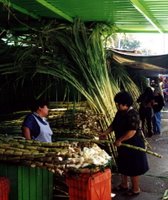 υποτίθεται ότι ανοίγουν οι πύλες για να έρθουν οι νεκροί. Στην αγορά βρίσκεις καλάμια από ζαχαροκάλαμα που με αυτά θα φτιαχτεί ο βωμός ή αλλιώς “ofrenda” (προσφορά). Αρχικά σε ένα τραπέζι θα τοποθετηθούν κουτιά που θα αναπαριστούν τους τάφους και θα πρέπει να καλυφθούν με λευκό τραπεζομάντιλο ή με χάρτινο τραπεζομάντιλο κομμένο σε πολλά σημεία σαν κεντητό σε δι
υποτίθεται ότι ανοίγουν οι πύλες για να έρθουν οι νεκροί. Στην αγορά βρίσκεις καλάμια από ζαχαροκάλαμα που με αυτά θα φτιαχτεί ο βωμός ή αλλιώς “ofrenda” (προσφορά). Αρχικά σε ένα τραπέζι θα τοποθετηθούν κουτιά που θα αναπαριστούν τους τάφους και θα πρέπει να καλυφθούν με λευκό τραπεζομάντιλο ή με χάρτινο τραπεζομάντιλο κομμένο σε πολλά σημεία σαν κεντητό σε δι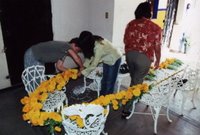 άφορα χρώματα. Με τα ζαχαροκάλαμα θα φτιαχτεί μια αψίδα όπου οι γυναίκες θα γεμίσουν με λουλούδια, κυρίως χρυσάνθεμα που θεωρούνται τα λουλούδια των νεκρών. Η φωτογραφίες του νεκρού θα τοποθετηθούν στο βωμό μαζί με αγαπημένα του πράγματα, αντικείμενα βοηθήσουν την ψυχή να φτάσει πιο εύκολα στο σπίτι της. Η ψυχή θα βρει ακόμα μεγαλύτερη βοήθεια στους παραδοσιακά φτιαγμένους βωμούς όπου η οικογένεια φτιάχνει ένα μονοπάτι από το δρόμο μέχρι το βωμό, γεμάτο λουλούδια και αναμμένα κεριά. Μεγάλη σημασία
άφορα χρώματα. Με τα ζαχαροκάλαμα θα φτιαχτεί μια αψίδα όπου οι γυναίκες θα γεμίσουν με λουλούδια, κυρίως χρυσάνθεμα που θεωρούνται τα λουλούδια των νεκρών. Η φωτογραφίες του νεκρού θα τοποθετηθούν στο βωμό μαζί με αγαπημένα του πράγματα, αντικείμενα βοηθήσουν την ψυχή να φτάσει πιο εύκολα στο σπίτι της. Η ψυχή θα βρει ακόμα μεγαλύτερη βοήθεια στους παραδοσιακά φτιαγμένους βωμούς όπου η οικογένεια φτιάχνει ένα μονοπάτι από το δρόμο μέχρι το βωμό, γεμάτο λουλούδια και αναμμένα κεριά. Μεγάλη σημασία 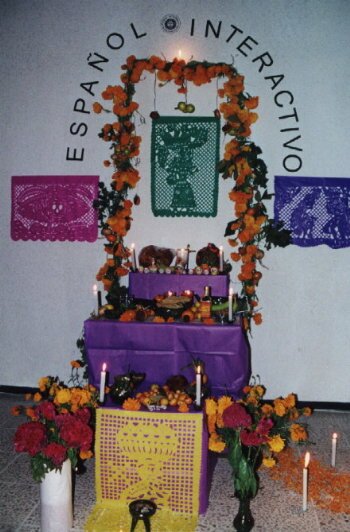 για την ημέρα έχουν οι προσφορές του βωμού. Απαραίτητα είναι τα ζαχαρωτά σε σχήμα κρανίου ή σκελετού, το “pan de muerto” (ψωμί του νεκρού), σοκολάτα, φρέσκα φρούτα και άλλα πολλά . Αν ο νεκρός το έτσουζε λίγο παραπάνω, το “Mezcal” θα έχει περίοπτη θέση και αν κάπνιζε τότε θα τα χρειαστεί και τα τσιγάρα του. Στα κεράσματα της ημέρας την τιμητική τους έχουν τα “Calaveras” και οι “catrinas”. Τα Calaveras, που ουσιαστικά σημαίνει κρανία, είναι κεράσματα φτιαγμένα από ζάχαρη. Με την λέξη αυτή όμως εννοούνται όλα τα κεράσματα που αναπαριστούν είτε είναι κρανία, είτε φέρετρα, τάφους ή σκελετούς. Μεγαλύτερης αξίας πάντως είναι τα κρανία στα οποία γράφεται το όνομα του νεκρού στο μέτωπο και τα παιδιά συνηθίζουν να τα ανταλλάσουν μεταξύ τους (έχω δύο Carlos, πάρε ένα και δώσε μου ένα Pablito). Τα Calaveras μπορεί να είναι και φιγούρες από ξύλο ή πηλό και αναπαριστούν σκελετούς σε διάφορα επαγγέλματα, μια αναπαράσταση της κοινωνίας. Φημισμένος για τις φιγούρες του είναι ο Jose Guadalupe Posada (1852-1913). Οι catrinas είναι επίσης φιγούρες, μόνο που είναι απαραίτητο να είναι γυναίκα ντυμένη με ρούχα του 19ου αιώνα. Συμβολίζει το θάνατο που μπορεί να σε βρει οποιαδήποτε στιγμή. Πιστεύεται πάντως ότι η χρήση του κρανίου προέρχεται από τους Aztec που τα χρησιμοποιούσαν κατά τη διάρκεια της τελετής ως τρόπαια, με αυτά τιμούσαν τους νεκρούς και συμβόλιζαν τον θάνατο αλλά και την αναγέννηση. Ημέρα των νεκρών χωρίς ψωμί δεν γίνεται. Την ημέρα της γιορτής οι φούρνοι δεν μπορούν να καλύψουν την ζήτηση. Το “pan de muerto” είναι συνήθως στρόγγυλο και θεωρείται μεγάλη τύχη να βρεις μέσα του ένα μικρό πλαστικό σκελετούλι που έκρυψε ο φούρναρης (κάτι σαν το φλουρί της βασιλόπιτας δηλαδή). Πέρα από το φαγητό όμως και το στόλισμα των βωμών, οι οικογένειες φτιάχνουν τα calacas, μάσκες φτιαγμένες από πεπιεσμένο χαρτί όπου τα παιδιά ζωγραφίζουν κρανία. Όλα τα παραπάνω είναι μόνο η προετοιμασία.
για την ημέρα έχουν οι προσφορές του βωμού. Απαραίτητα είναι τα ζαχαρωτά σε σχήμα κρανίου ή σκελετού, το “pan de muerto” (ψωμί του νεκρού), σοκολάτα, φρέσκα φρούτα και άλλα πολλά . Αν ο νεκρός το έτσουζε λίγο παραπάνω, το “Mezcal” θα έχει περίοπτη θέση και αν κάπνιζε τότε θα τα χρειαστεί και τα τσιγάρα του. Στα κεράσματα της ημέρας την τιμητική τους έχουν τα “Calaveras” και οι “catrinas”. Τα Calaveras, που ουσιαστικά σημαίνει κρανία, είναι κεράσματα φτιαγμένα από ζάχαρη. Με την λέξη αυτή όμως εννοούνται όλα τα κεράσματα που αναπαριστούν είτε είναι κρανία, είτε φέρετρα, τάφους ή σκελετούς. Μεγαλύτερης αξίας πάντως είναι τα κρανία στα οποία γράφεται το όνομα του νεκρού στο μέτωπο και τα παιδιά συνηθίζουν να τα ανταλλάσουν μεταξύ τους (έχω δύο Carlos, πάρε ένα και δώσε μου ένα Pablito). Τα Calaveras μπορεί να είναι και φιγούρες από ξύλο ή πηλό και αναπαριστούν σκελετούς σε διάφορα επαγγέλματα, μια αναπαράσταση της κοινωνίας. Φημισμένος για τις φιγούρες του είναι ο Jose Guadalupe Posada (1852-1913). Οι catrinas είναι επίσης φιγούρες, μόνο που είναι απαραίτητο να είναι γυναίκα ντυμένη με ρούχα του 19ου αιώνα. Συμβολίζει το θάνατο που μπορεί να σε βρει οποιαδήποτε στιγμή. Πιστεύεται πάντως ότι η χρήση του κρανίου προέρχεται από τους Aztec που τα χρησιμοποιούσαν κατά τη διάρκεια της τελετής ως τρόπαια, με αυτά τιμούσαν τους νεκρούς και συμβόλιζαν τον θάνατο αλλά και την αναγέννηση. Ημέρα των νεκρών χωρίς ψωμί δεν γίνεται. Την ημέρα της γιορτής οι φούρνοι δεν μπορούν να καλύψουν την ζήτηση. Το “pan de muerto” είναι συνήθως στρόγγυλο και θεωρείται μεγάλη τύχη να βρεις μέσα του ένα μικρό πλαστικό σκελετούλι που έκρυψε ο φούρναρης (κάτι σαν το φλουρί της βασιλόπιτας δηλαδή). Πέρα από το φαγητό όμως και το στόλισμα των βωμών, οι οικογένειες φτιάχνουν τα calacas, μάσκες φτιαγμένες από πεπιεσμένο χαρτί όπου τα παιδιά ζωγραφίζουν κρανία. Όλα τα παραπάνω είναι μόνο η προετοιμασία.
(ζαχαρωτό calavera)
(pan den muerto)
(φιγούρες calaveras από τον Posada)
(catrina από τον Posada)
(παιδιά χορεύουν με χορευτή που φοράει calaca)
Πρώτα έρχονται πίσω τα νεκρά παιδιά. Η ημέρα είναι γνωστή και ως "Día de los Angelitos" δηλαδή «Ημέρα των μικρών αγγέλων». Τον πρώτο χρόνο μετά το θάνατο του παιδιού, την υποχρέωση για βωμό την έχει ο νονός του, ο οποίος θα φτιάξει και το βωμό ως ένδειξη σεβασμού προς την οικογένεια αλλά και θα εορτασμό για την ζωή του παιδιού. Πέρα από τα φαγητά και τα φρούτα, στο βωμό θα τοποθετηθούν και παιχνίδια αλλά και ένα ροζάριο για προσευχή προς την Παρθένο Μαρία.
Στις 2 Νοεμβρίου που επιστρέφουν και οι νεκροί ενήλικες, γίνεται το πραγματικό πανηγύρι. Άντρες γυναίκες και παιδιά θα πάνε στο νεκροταφείο για την προετοιμασία του τάφου. Το πρωί είναι αφιερωμένο στο καθάρισμα του τάφου και στο στόλισμά του.
(οικογένεις στο νεκροταφείο το πρωί της 2ας Νοεμβρίου)
Ξεραμένα λουλούδια απομακρύνονται, χώματα καθαρίζονται και αρχίζει το στόλισμα, το οποίο περιλαμβάνει από μερικά λουλούδια έως και ολόκληρη κατασκευή αναπαράστασης με χρυσάνθεμα και άλλα μικρά χρωματιστά λουλούδια. Αν η οικογένεια δεν έχει τα οικονομικά μέσα για να φτιάξει βωμό στο σπίτι, τότε βωμός είναι η τελευταία κατοικία του πεθαμένου. Φαγητά, ποτά, φωτογραφίες και αγαπημένα αντικείμενα και απαραιτήτως κεριά μπαίνουν στις σωστές θέσεις. Τα παιδιά εκπαιδεύονται από τους μεγαλύτερους γ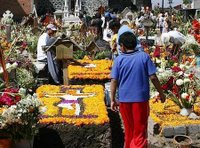 ια να ξέρουν τι θα πρέπει να κάνουν αργότερα όταν έρθει η σειρά τους και κάποιοι ντύνονται και βάφονται σαν σκελετοί. Όταν τελειώσει ο στολισμός, η οικογένεια περνά την υπόλοιπη ημέρα στο νεκροταφείο, τραγουδώντας, λέγοντας ιστορίες για τον συγχωρεμένο, κάνοντας κοινωνικές συναναστροφές. Κάποιοι χορεύουν προς τιμή των νεκρών. Μέχρι τις 12 το βράδυ που θα ανάψουν τα κεριά. Τότε το νεκροταφείο μετατρέπεται σε ένα πανέμορφο μέρος με εκατοντάδες κεράκια αναμμένα και όλοι περιμένουν τους αγαπημένους τους να γυρίσουν από τον άλλο κόσμο. Ποτήρια με νερό υπάρχουν παντού, καθώς και απλωμένα σεντόνια. Ο νεκρός θα είναι κουρασμένος από το ταξίδι, θα θέλει να ξεδιψάσει, να φάει και να ξεκουραστεί. Αργότερα τα παιδιά και οι μεγάλοι θα φάνε και θα πιουν αλλά οι γιαγιάδες και οι παππούδες πιστεύουν ότι τίποτα από αυτά δεν είναι θρεπτικό αφού ότι είναι χρήσιμο το έχει πάρει ήδη ο νεκρός. Κάποιες οικογένειες περνάν όλο το βράδυ μέχρι το επόμενο πρωί στο νεκροταφείο παρέα με τους συγχωρεμένους.
ια να ξέρουν τι θα πρέπει να κάνουν αργότερα όταν έρθει η σειρά τους και κάποιοι ντύνονται και βάφονται σαν σκελετοί. Όταν τελειώσει ο στολισμός, η οικογένεια περνά την υπόλοιπη ημέρα στο νεκροταφείο, τραγουδώντας, λέγοντας ιστορίες για τον συγχωρεμένο, κάνοντας κοινωνικές συναναστροφές. Κάποιοι χορεύουν προς τιμή των νεκρών. Μέχρι τις 12 το βράδυ που θα ανάψουν τα κεριά. Τότε το νεκροταφείο μετατρέπεται σε ένα πανέμορφο μέρος με εκατοντάδες κεράκια αναμμένα και όλοι περιμένουν τους αγαπημένους τους να γυρίσουν από τον άλλο κόσμο. Ποτήρια με νερό υπάρχουν παντού, καθώς και απλωμένα σεντόνια. Ο νεκρός θα είναι κουρασμένος από το ταξίδι, θα θέλει να ξεδιψάσει, να φάει και να ξεκουραστεί. Αργότερα τα παιδιά και οι μεγάλοι θα φάνε και θα πιουν αλλά οι γιαγιάδες και οι παππούδες πιστεύουν ότι τίποτα από αυτά δεν είναι θρεπτικό αφού ότι είναι χρήσιμο το έχει πάρει ήδη ο νεκρός. Κάποιες οικογένειες περνάν όλο το βράδυ μέχρι το επόμενο πρωί στο νεκροταφείο παρέα με τους συγχωρεμένους.
Έρχεται ο Χάρος φορώντας
Χίλια υπέροχα χρώματα
Έλα, δώσε μου ένα φιλί, Θάνατε,
Γιατί έχω ορφανέψει από αγάπες
Ανώνυμο μεξικάνικο ποίημα
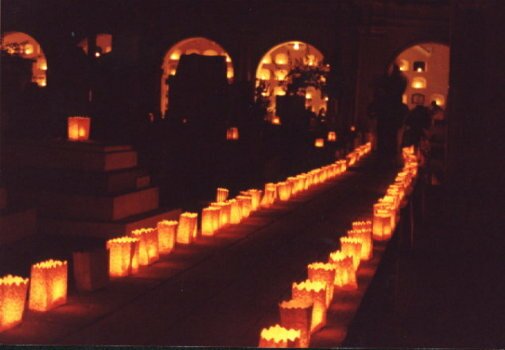 Το Μεξικό είναι μια τεράστια χώρα και είναι φυσικό να υπάρχουν παραλλαγές από περιοχή σε περιοχή. Η ουσία όμως είναι αυτή που μένει η ίδια. Το αγγλικό “I will dance on your grave” για τους μεξικάνους δεν είναι προσβολή αλλά προτροπή. Ο θάνατος είναι ένα γεγονός το ίδιο σημαντικό με μια γέννα και θα πρέπει να γιορτάζεται με χαρά. Δεν κλαίμε για τους νεκρούς μας αλλά χαιρόμαστε για αυτούς, που βρήκαν πια το πραγματικό νόημα της ζωής.
Το Μεξικό είναι μια τεράστια χώρα και είναι φυσικό να υπάρχουν παραλλαγές από περιοχή σε περιοχή. Η ουσία όμως είναι αυτή που μένει η ίδια. Το αγγλικό “I will dance on your grave” για τους μεξικάνους δεν είναι προσβολή αλλά προτροπή. Ο θάνατος είναι ένα γεγονός το ίδιο σημαντικό με μια γέννα και θα πρέπει να γιορτάζεται με χαρά. Δεν κλαίμε για τους νεκρούς μας αλλά χαιρόμαστε για αυτούς, που βρήκαν πια το πραγματικό νόημα της ζωής.
Πηγές (που πραγματικά αξίζει κανείς να διαβάσει)
http://www.questconnect.org/oaxaca_photo_index.htm
http://members.aol.com/Bazlukes/LosMuertes.htm
http://en.wikipedia.org/wiki/Day_of_the_Dead
http://www.public.iastate.edu/~rjsalvad/scmfaq/muertos.html
Ιδιαιτερη βοήθεια πήρα απο το http://www.azcentral.com/ent/dead/ όπου θαβρείτε και ντοκυμαντέρ για την ετοιμασία και τον εορτασμό της ημέρας καθώς και slide shows.
Posted by...Unknown at 12:19 μ.μ. 7 comments
Ακόμα πουλούν στους ιθαγενείς "καθρεπτάκια" για να πάρουν χρυσάφι;
Σάββατο, Οκτωβρίου 28, 2006
 Llama Subcomandante a defender unidad de los pueblos
Llama Subcomandante a defender unidad de los pueblos
Como un gran engaño para desaparecer a los pueblos indios del Pacífico consideró el Subcomandante Marcos el proyecto de la Escalera Náutica, donde la tierra será convertida en mercancía.
Ο Subcomandante Marcos θεωρεί σαν μεγάλη απάτη το σχέδιο Escalera Náutica, σύμφωνα με το οποίο η γη θα μετατραπεί σε εμπόρευμα.
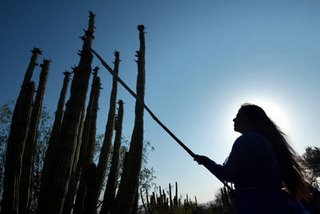 Ante un centenar de personas, en su mayoría indígenas y extranjeros, el ahora Delegado Zero de la Comisión Sexta del Ejército Zapatista de Liberación Nacional (EZLN) llamó a la unidad para defender a los pueblos.
Ante un centenar de personas, en su mayoría indígenas y extranjeros, el ahora Delegado Zero de la Comisión Sexta del Ejército Zapatista de Liberación Nacional (EZLN) llamó a la unidad para defender a los pueblos.
Μπροστά σε μια εκατοστή ανθρώπων, στην πλειοψηφία τους ιθαγενών και ξένων, ο τώρα επονομαζόμενος Delegado Zero της Comisión Sexta του EZLN (Eθνικός Απελευθερωτικός Στρατός των Zαπατίστας) ζήτησε και πρότεινε την ενότητα για να μπορέσουν να προστατευτούν τα χωριά.
 “Durante décadas enteras hemos estado viviendo con enfermedades, sin educación, arañando la tierra para poder sacarle algo de producto y ahora quieren también esa tierra.
“Durante décadas enteras hemos estado viviendo con enfermedades, sin educación, arañando la tierra para poder sacarle algo de producto y ahora quieren también esa tierra.
Για ολόκληρες δεκαετίες έχουμε ζήσει με ασθένειες, χωρίς παιδεία, γρατζουνώντας την γη για να μπορέσουμε να βγάλουμε κάποιο προϊόν και τώρα θέλουν ακόμα και αυτήν την γη.
“La Escalera Náutica significará la desaparición total del pueblo yoreme, Mayo, de los yaquis, de los kukapás y de toda la costa de Sonora y Sinaloa y de Baja California y Baja Sur, para empresas hoteleras y turísticas”, apuntó.
«Η Escalera Náutica θα σημάνει την ολοκληρωτική εξαφάνιση της φυλής Υoreme, Mayo, των Yaquis, των Κukapás και όης της ακτής της Sonora και της Sinaloa, της Baja California και της Baja Sur, για χάρη τουριστικών και ξενοδοχειακών επιχειρήσεων», συμπλήρωσε.
 La noche del sábado el líder zapatista advirtió que sólo habrá mentiras de parte del Gobierno estatal que en los próximos días podría buscar un acercamiento con los representantes de las etnias.
La noche del sábado el líder zapatista advirtió que sólo habrá mentiras de parte del Gobierno estatal que en los próximos días podría buscar un acercamiento con los representantes de las etnias.
Το βράδυ του Σαββάτου ο αρχηγός των Zapatistas προειδοποίησε ότι θα υπάρξουν μόνο ψέμματα εκ μέρους της Κυβέρνησης, που τις επόμενες μέρες θα προσπαθήσει να βρει κοινές πηγές σύγκλισης με τους εκπροσώπους των φυλών και των κοινοτήτων.
“Los que están allá arriba, compañeras y compañeros de Sonora, yaquis, yoremes, kukapás, o’othams, sólo los van a engañar. Van a comprar a uno o dos de ustedes, los van a pasear por todo el mundo, pero su pueblo va a desaparecer”.
»Όσοι θα είστε εκεί πάνω, σύντροφοι και συντρόφισσες της Sonora, yaquis, yoremes, kukapás, o’othams, προσέξτε γιατί το μόνο που θέλουν είναι να σας εξαπατήσουν. Θα εξαγοράσουν έναν ή δυο από εσάς, θα σας γυρίσουν σε όλο τον κόσμο, αλλά ο λαός σας θα εξαφανιστεί».
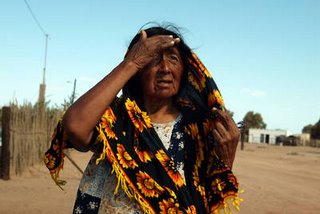 “Eso es lo que va a hacer el Gobierno de Sonora después de esta reunión, lo van a ver, va a declarar que va a resolver el problema indígena, los va a buscar a ustedes, los va a llevar a los grandes hoteles, les va a dar de comer bien y les va a poner papeles para que los firmen, les va a dar unas despensas y unos créditos, pero nada, absolutamente nada, va a cambiar en sus pueblos”, subrayó.
“Eso es lo que va a hacer el Gobierno de Sonora después de esta reunión, lo van a ver, va a declarar que va a resolver el problema indígena, los va a buscar a ustedes, los va a llevar a los grandes hoteles, les va a dar de comer bien y les va a poner papeles para que los firmen, les va a dar unas despensas y unos créditos, pero nada, absolutamente nada, va a cambiar en sus pueblos”, subrayó.
»Αυτό θα κάνει η Κυβέρνηση της Sonora μετά την συνάντηση, θα το δείτε, θα ανακοινώσει ότι πρόκειται να λύσει το πρόβλημα των ιθαγενών, θα στείλει να σας βρουν, θα σας πάει σε μεγάλα ξενοδοχεία, θα σας δώσει να φάτε καλά και θα σας βάλει να υπογράψετε χαρριά, θα σας δώσει κάποιες προμήθειες και πίστωση, αλλά τίποτα, απολύτως τίποτα δεν θα αλλάζει στα χωριά σας», υπογράμμισε.
El Subcomadante Marcos anunció que en octubre de 2007 se realizará en el Noroeste mexicano, posiblemente en Sonora, un encuentro continental de pueblos originales.
Ο Subcomadante Marcos ανακοίνωσε ότι τον Οκτώβρη του 2007 θα πραγματοποιηθεί στο Βορειανατολικό Μεξικό, ίσως στην Sonora, μία παγκόσμια συνάντηση αυτοχθόνων λαών.
Omán Nevárez, enviado
onevarez@elimparcial.com
MAGDALENA DE KINO, Sonora(PH)
Nota Publicada: 22/10/2006 9:42 am
http://www.elimparcial.com/edicionenlinea/notas/Noticias/20061022/144976.asp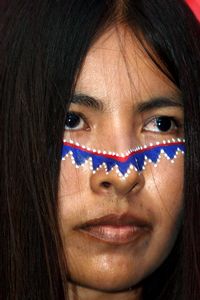
Για το πρόγραμμα-φάντασμα (όπως αποκαλεί μερίδα του Μεξικανικού λαού) Escalera Náutica που μετονομάστηκε σε πρόγραμμα Mar de Cortés, ακολουθούν κάποια κατατοπιστικά άρθρα.
http://www.jornada.unam.mx/2006/10/24/012n1pol.php
http://www.jornada.unam.mx/2006/10/23/017n1pol.php
http://www.jornada.unam.mx/2006/10/26/041n1est.php
http://www.jornada.unam.mx/2006/07/14/022n1pol.php
http://chiapas.mediosindependientes.org/display.php3?article_id=137036
http://www.conservacion.org.mx/pdf/Escalera%20Nautic%E2%80%A6orientacion.pdf
http://www.elimparcial.com/buscar/traernotanew.asp?NumNota=419102
http://www.ine.gob.mx/enautica/index.html
http://www.jornada.unam.mx/2005/05/23/048n1pol.php
http://www.jornada.unam.mx/2005/05/23/048n2pol.php
Posted by...Juanita La Quejica at 4:10 μ.μ. 2 comments
Oι φωτογραφίες μιας γυναίκας
 Pure your gentle name, pure your fragile life,
Pure your gentle name, pure your fragile life,bees, shadows, fire, snow, silence and foam,
combined with steel and wire and
pollen to make up your firm
and delicate being.
Μ' αυτούς τους στίχους ο Pablo Neruda έκλεισε στα 1942 τον επικήδειό του στην Tina Modotti, στην πόλη του Μεξικού.
χάνοντας τον εαυτό μου στο μυστήριο της τέχνης
Τα λόγια τούτα είναι της ίδιας της Modotti, από έναν άλλο επικήδειο, που δεν εκφωνήθηκε ποτέ μπροστά σε κάποιο πλήθος. Γράφτηκαν μόνο, στα 1927, στο προσωπικό της ημερολόγιο κατα τη μέρα που αποφάσισε να παραμερίσει την καριέρα της ως φωτογράφος και ηθοποιός για να ενταχθεί στο Κομμουνιστικό Κόμμα του Μεξικού. Εκείνη, μια Ιταλίδα, γεννημένη στο Ούντινε στα 1896, βρέθηκε στην Αμερική να πρωταγωνιστεί τη δεκαετεία του '20 σε βουβές ταινίες κινηματογράφου και αργότερα να ποζάρει ως μοντέλο για φωτογράφους.
Το νήμα της ζωής της δεν το ξετύλιξε ωστόσο η ίδια αλλά οι άντρες που έτυχε να γνωρίσει. Παράνομη ερωμένη του φωτογράφου Edward Wenston εγκαταλείπει τον άντρα της και φεύγει μαζί του για το Μεξικό στα 1922 όπου, μετά το τέλος της σχέσης τους, γνωρίζει την ίδια χρονική περίοδο και εμπλέκεται σε ένα ερωτικό τρίγωνο με δυο άνδρες που στιγμάτισαν όχι μονο τη δική της προσωπική της ιστορία αλλά τόσο του Μεξικού όσο και την παγκόσμια: τον Julio Mella, ιδρυτή του "Διεθνοποιημένου" Κομμουνιστικού Κόμματος της Κούβας, και του Vittorio Vidali, μετέπειτα δολοφόνου του Τρότσκυ.
Ο πρώτος δολοφονείται στα 1929 κι η μεξικανική αστυνομία κατ' ουσίαν της φορτώνει με παρακρατικές μεθόδους την εκτέλεσή του. Κατά τη διάρκεια των ανακρίσεων καθίσταται επίσης ύποπτη για σχεδιασμό της δολοφονίας του μεξικάνου προέδρου με αποτέλεσμα το 1930 να απελαθεί από τη χώρα μαζί με τον Vidali. Καταφεύγουν στο Βερολίνο κι από κεί στη Μοσχα όπου στρατολογούνται από το σταλινικό καθεστώς ως πράκτορες. Αργότερα, στην Ισπανία του Φράνκο παίρνει μέρος στον ισπανικό εμφύλιο και εγκαταλείπει τη χώρα με την κατάρρευση του Δημοκρατικού Στρατού. Επιστρέφει με τον Vidali στο Μεξικό με μυστική ταυτότητα αυτή τη φορά, όπου και πεθαίνει το 1942. Εικάζεται οτι ο θάνατος της δεν ήταν από φυσικά αίτια. Μια εκδοχή μιλά για ενορχήστρωσή του από τον Vidali , για τη δολοφονική του δράση του οποίου γνώριζε πολλά (ο Vidali στην Ισπανία είχε αποκτήσει το προσωνύμιο Commandate Carlos για τις σταλινικές του εκκαθαρίσεις). Μια άλλη εκδοχή μιλά για εντοπισμό της από τις μεξικανκές αρχές οι οποίες δεν είχαν ξεχάσει τη δράση της στους κολπους του Κ.Κ.ΜΕ. αλλά και...
...τη μια και μοναδική της έκθεση της Modotti στην πόλη του Μεξικού στις αρχές του 1929, η οποία έχει χαρακτηριστεί ως η πρώτη "Επαναστατική Φωτογραφική Έκθεση" στο Μεξικό. Σε αυτήν εκτέθηκαν εικόνες από την επταετή περιήγησή της στη χώρα - μια καταγραφή εικόνων με εξαιρετικής ευαισθησίας της φτώχειας κι εξαθλίωσης του μεξικανικού λαού και των Ινδιάνων μια μόνο δεκαετεία μετά τον τερματισμού του εμφυλίου. Οι φωτογραφίες της Modetti, που αποτελούν πολύτιμο ιστορικό ντοκουμέντο για την κατανόηση της κοινωνικής ζωής της εποχής, έχουν την σπάνια ιδιαιτερότητα να υπηρετούν την πολιτική της στράτευση χωρίς ωστόσο να μειώνεται το αισθητικό αντίβαρο που στην περίπτωσή της συνίσταται στην προοπτική και αρχιτεκτονική της εικόνας στα πρότυπα του bauhaus.
Από την εν λόγω έκθεση παραθέτω (επιλεκτικά):
Posted by...οι σκιές μιλάν at 2:45 π.μ. 8 comments
Οι Σκιές μίλησαν για τους Ανθρώπους από Καλαμπόκι
Παρασκευή, Οκτωβρίου 27, 2006
Χτες ήρθε ένα mail από τον Οι Σκιές Μιλάν -με κάποιες φωτογραφίες που βρήκε τυχαία στο internet. Θέλω να τον ευχαριστήσω που με σκέφτηκε και μου τις έστειλε. Και ελπίζω να μην τον πειράζει που αναφέρομαι σε αυτόν -είμαι και γέρος άνθρωπος, μπορεί να έχω βριστεί μαζί του στο παρελθόν. Αλλά τι σημασία έχει;
Οι φωτογραφίες:

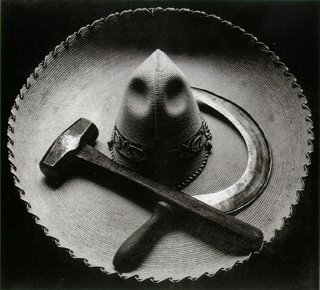
μου άρεσαν και οι δυο το ίδιο. Και, όχι -δεν με χάλασε το σφυροδρέπανο. Επειδή δηλαδή, κάποιοι το χρησιμοποίησαν για να δικαιολογήσουν την εξουσιαστική τους ψύχωση -δεν πάει να πει πως η ιστορία πίσω από το σύμβολο ακυρώθηκε.
Αυτά.
Αν τώρα, κάποιος έχει ιδέες σχετικά με το τι θα μπορούσαμε να κάνουμε με τις συγκεκριμένες φωτογραφίες στο Καλαμπόκι (και banner γίνονται και εικόνες για id και ότι θέλεις γίνονται) -ας τις γράψει. Κι αν κάποιος θέλει να χρησιμοποιήσει καμιά από αυτές -ας το κάνει. Ελεύθερα. Αρκεί να θυμάται πως τα έξτρα ευχαριστώ πάνε στις Σκιές που μιλάν.
Posted by...The Motorcycle boy at 11:07 π.μ. 6 comments
A Chiapas Decade: Zapatista Perspectives
 The beginning of the New Year for 2004 marked the tenth anniversary of the Zapatista armed revolution in Chiapas Mexico. It was in the dark, cold, early hours of 1994 that the Mayan peasant soldiers captured several towns in revolt of the oppression they had endured since Cortez wandered into Southern Mexico. Their complaints were that they were given no autonomy to preserve their culture; no political or judicial rights to fight confiscation of their land and freedom; and no fair division of government services to educate and provide medical services. They argued that their ability to provide food and shelter for their families by farming, as they had for centuries, was taken from them by domestic patronage and later international agreements. They argued that the schools, infrequently open, were more interested in convincing their children to abandon their culture than teaching them.
The beginning of the New Year for 2004 marked the tenth anniversary of the Zapatista armed revolution in Chiapas Mexico. It was in the dark, cold, early hours of 1994 that the Mayan peasant soldiers captured several towns in revolt of the oppression they had endured since Cortez wandered into Southern Mexico. Their complaints were that they were given no autonomy to preserve their culture; no political or judicial rights to fight confiscation of their land and freedom; and no fair division of government services to educate and provide medical services. They argued that their ability to provide food and shelter for their families by farming, as they had for centuries, was taken from them by domestic patronage and later international agreements. They argued that the schools, infrequently open, were more interested in convincing their children to abandon their culture than teaching them.
Their complaints continue to have outside verification. It appears incontrovertible that eighty percent of the Mayans in Chiapas are malnourished and their average life span is well under 50 years. The World Bank recently reported on the education for the children of Chiapas as being unacceptable. Children do die of preventable diseases and there are few medical facilities. Land has been confiscated without legal recourse from the farmers as political favors to corporate ranchers, and oil explorers. Ironically, this condition exists in one of the richest states of natural resources in the Western Hemisphere.
Although the beginning of the Zapatista movement came to public light in the bloody days of January 1994, the beginning actually occurred ten years before. The best-kept secret in Mexico was the decade of development before the first shot was fired. During this time the Mayans decided to name themselves “Zapatistas” after Emiliano Zapata, the people’s revolutionary of the early 1900’s, known for his declaration: “It is better to die on your feet than live on your knees.” Women’s rights benefited from the revolution within the revolution. In the past women could be cheaply purchased for marriage. They had little say about their lives. At the time of the fighting the women’s lot dramatically changed, evidenced by fully half of the Central Counsel, (the governing body for the several Mayan tribes), were women.
The fighting in 1994 began less than two hours after NAFTA went into effect. The Zapatistas believed, later to be proved correct, that NAFTA would provide the death nail to the centuries of economy and culture of the original inhabitants who survived by toiling the land. Their mainstay was corn. Soon genetically altered corn, subsidized by the United States and other countries, and marketed by global corporations, flooded the Mexican ecconomy. Their price and supporting infrastructure cut the Mayan farmers out of their limited marketplace.
Several towns were captured at the beginning of the struggle. The largest and most important was San Cristobal de las Casas, a 16th century colonial town nestled in the starkly beautiful trans-volcanic region of the Sierra Madre Mountains. The poorly armed peasant soldiers pulled a modern day Trojan Horse coup. Over three hundred and fifty Zapatistas joined the Mexican Army six months before the attack. Some Zapatistas also joined the security police in San Cristobal. These rebels volunteered to stay on duty during the holidays so the commanding officer of the military had helicopters, automatic weapons and the like, but fewer troops than he thought to lead into battle. Later it became obvious that some of the rebels were trained and armed by the very army that was charged with the responsibility to put them down.
The Mexican Army soon regrouped and took back San Cristobal but not before the Zapatistas FAX’ed out press releases to journalists around the world. As if by magic reporters descended upon the colonial municipality. Marcos, a spokesman for the rebels, rewarded the reporters with intellectual, fiery—even poetic—speeches. Marcos, a past professor from Mexico City, was one of the few leaders of the movement not Mayan. He moved to Chiapas a decade before, dedicated to reversing the plight of the Indigenous People. He made a striking figure with his ski mask, military cap with stars, bandoleers, and an automatic weapon stuck in his belt. Often a pipe stuck through the mask and haloed smoke around his head in mystic fashion. Stories of the Mayans swept the world. The Mexican government, especially because of the balancing act of NAFTA in the United States, was faced with more of a diplomatic and public relations problem than a military one. Eventually a cease-fire was affected and the government, extending certain autonomy and civil rights to the Indigenous people, signed the San Andres Accord. The PRI, ruling party of Mexico for over seventy years, never honored the letter or spirit of the agreement. A tense truce, punctuated by violence against the Zapatistas by paramilitary groups, has existed since.
To this day the Mexican government must deal with the prospect of the Indigenous People in the mountains and Lancandon rain forest creating an in-country Viet Nam and new meaning to Janice Joplin’s words: “Freedom’s just another word for nothing left to lose.”
When in 2000 President Fox broke the political strangle hold of the PRI and made overtures of peace, the Zapatistas clung to a hope that their demands for constitutional rights would be honored. Based upon President Fox’s declarations the commandantes caravanned to Mexico City. The multi-week cavalcade stirred the hearts and minds of the people of Mexico. The banners and speeches were inclusive of all people who were repressed and not limited to Indigenous People. Marcos gave a stirring speech when the comandantes arrived at the Plaza in Mexico City. The huge historic area was filled with people of all walks of life.
Fox scheduled a joint meeting of Congress to hear from a Zapatista representative. Notably, Marcos was not that representative, but instead a Mayan woman. Sadly, it was also notable that very few of the legislators showed up—including members of Fox’s own party. The result was the passage of a watered down constitutional amendment, which did not reflect the agreement of the San Andres Accord. Attempts by the Mayan people to effect change within the system after that were violently blocked, resulting in a retrenchment into autonomous, self-governing enclaves throughout southern Mexico.
Beginning December 28th of last year, I spent a week at the Zapatista highland compound known as Caracol Dos, with the “Schools for Chiapas Delegation for Peace”, celebrating the end of the year festival as well as the tenth anniversary of their armed revolution. I flew to Mexico City, then Tuxtla Gutierrez, and finally overland to the picturesque hamlet of San Cristobal. My Spanish is less than adequate, but after the kind and longsuffering help of my driver and passersby, I was able to find a hostel used by the Zapatistas. Next door was a Zapatista office adorned with the movement’s name and an impressive red star I was greeted with kindness and found help for my poor Spanish. I took my backpack upstairs to a small room with a cot. The walls were bare and a single naked light bulb hung from the ceiling. The door opened with a device attached to a string. There was no lock. I naively thought this was the roughing it part of my travels. The next day the rest of the delegation, forty-seven in all, arrived. I spent the interim time until their arrival wandering around the square of one of the most delightful of towns.
The rest of the delegation was a story in and of itself. They were almost all in their twenties. Many were still students in undergrad or grad school. They were a good-looking, intelligent, chirpy lot. Those who had full time jobs were with non-profits, community development etc. They were spending their time going from one volunteer humanitarian project to another. They were from the United States, Canada, Australia, Europe, South and Central America. Two young delightful women were filming a documentary as a project for their college in Sweden. One young man from Central America was filming his second documentary of the Zapatistas independently. He did not want to receive any money for his project, just tell a story worth telling. One delegate just arrived from volunteering at an agricultural project in Guatemala. All were from somewhere or going somewhere that was impressive to me because it was like a throwback to the 1960’s. Everyone was trying to do something good for whatever worthwhile cause they could find. I’m afraid I am now through with my generation x jokes. They accepted this fifty-seven year old man into their group and it was fun.
The night before we left for Caracol Dos, we ate a simple meal in the courtyard of the hostel and listened to Amado Avendano. He is an attorney, journalist, as he put it, politician by accident. His newspaper carried many of the articles and letters by the Mayan people for several years. Over time he earned their trust. When the armed conflict began, he went out as a journalist to see what was going on. He met Marcos, who told him of their plan. He couldn’t believe that the Zapatistas intended to attack the heavily fortified military installation and did not go to with them. He could see the helicopters strafing the insurgents and flashes of explosions. It wasn’t until later that he learned of the “Trojan Horse” strategy that earned the rebel victory. His telling of this was the first time I had known of the tactic.
According to Avendano, he endured an assassination attempt by a car accident while he was on his way to Tuxtla for a campaign event in which the indigenous people had hoped to acquire a governor who would set up an interim government to oversee free local elections. The election victory was fraudulently given to a PRI candidate by the state government that must approve the results. Avendano said he was asked to be the governor for the Indigenous People in an autonomous region, which he has done, but the structure has slowly eroded away, leaving him venerable to governmental retaliation.
The trip to Caracol Dos took us through beautiful mountainous areas via a winding road. We rode on two buses that serviced the remote areas. A high fence surrounded the encampment, which bordered the road. I saw no armed guards. The rules of the compound forbade drugs, alcohol, and weapons. This rule provided my first New Years Eve with fifteen hundred sober people dancing to dawn. I was struck by the bold murals on the buildings. It seems to me that bold, colorful, emotional art is many times born from the emotion of people experiencing injustice.
Our delegation found two rooms in which to lay our sleeping bags. As I lay on the concrete floor in my room with over twenty roommates I, for the first time, appreciated the relative luxury of the hostel in San Cristobal. The community was not a village but a facility for the people of the mountains to use. We passed a general store, offices and stores for the collectives, clinic, kitchen and other facilities. At the end of the road stood the school and a huge outdoor basketball court. In our meeting with Zapatista leaders, those who ran the school and clinic, we discovered that no one took pay for these heroic efforts, but instead had second jobs or weaved art to sell so that they could survive. I bought a piece from each of the teachers, (they preferred to be called “Promoters” because they didn’t yet feel they had the credentials to be called teachers. The same is true with those who ran the clinic, which was open for free twenty-four/seven).
I later had an opportunity to tour the clinic. Several micro-clinics now are also operating in Chiapas. Medical services are in dire supply for these people. The clinic is free and the only facility in the area. Patients are treated with traditional Mayan and modern medicines. The ones that run the clinic have no special certifications and possessed only knowledge they had learned informally. The clinic itself has an Ob/gyn exam room, emergency room, optical department and a small general floor of beds.
I had read that the Mexican government built basketball courts throughout Chiapas in an effort to enhance the lives of the people. I wondered then how that would help people in need of the most basic services and who were, by basketball standards, short. The first day of my arrival I watched some young girls playing on the full regulation size court. They stood a mere fraction of the height of the goal and were wearing school uniform dresses. To my amazement they made many more baskets than I would have and ran tirelessly back and forth on the court. Later I watched some of the young men play most excellent basketball and they just didn’t get tired. During the festival our delegation was invited to play in a tournament. Several of our members were good athletes and quite tall, (I opted not to be on the team), but fortunately we were meeting with the promoters at the school and avoided what I feel would have been a major whipping. The performance of these young people was not a reflection of the wisdom of the government, whose president was a basketball fan, but instead the resilience of the Mayan people.
Caracol Dos is located in what has been labeled as a “low intensity war zone.” The vast majority of the Mexican army is stationed in southern Mexico. The people I talked to told me of the intimidation of low flying helicopters and troops roaring past in personnel carriers. Paramilitary groups have attacked Zapatista groups. I was told that the presence of our delegation would provide some protection from attack. I greeted this information with mixed emotions.
The first night we were at the compound a hastily called meeting gave us our first chance to meet a Zapatista welcoming committee. Three men in ski masks greeted us in a small building with dirt floors. They talked in general terms of their movement. They said their cause was for freedom and dignity. They talked of autonomy. It was in this meeting that I first garnered information about their efforts to run a school and clinic. The men explained that women had the same rights and duties as men. They opened the floor to questions and our little group let the queries fly. “Are you terrorists?” “No. We have a just cause which makes us different than terrorists.” I wanted to help him with his answer. Terrorists also think they have a just cause. It’s just that they incorporate unjust methods. I know that there is no reason to think that the Zapatistas have ever blown up a bus station or done some other act for the sole purpose of terror and wish that he could have made that distinction. At the end of the talk the men apologized for not being more eloquent and admitted to having little formal training yet I felt their simple and straightforward words were all the more effective.
One example of the restraint exercised by the leaders of this movement at the beginning of the revolt is the treatment of General Dominguez. Dominguez was the governor of Chiapas at the time of the revolt. If anyone person personified the evil that the Indigenous People were fighting, it was he. Dominguez was captured and later tried for crimes against the people. The tribunal found him guilty but, rather than executing him for the grievous acts, they released him. The results of this action highlighted the heinous acts of the state’s power structure but left no blood on the hands of the insurgents.
One characteristic about these people that most impressed me was their quiet dignity. No one asked for a handout and theyrefused to allow their children to do so. I was asked not to bring candy or trinkets because they did not want their children to learn to beg. They handled all of the social services without pay. Women joined together in collectives to make clothes and art to sell. The promoters of the school and clinic found ways to survive without pay or charity. The Zapatistas rejected what little subsidies that were available to them through the national government because it would be an intellectual and moral contradiction to their declaration of autonomy.. Their slogan most often repeated was “Liberty through Education”.
I met representatives of seventy-one displaced people taking shelter at Caracol Dos. They had been run off of their ancestral property and their attempt to return sacrificed the lives of several Zapatistas who tried to help. They were able to form a small musical band and cut a CD, which they sold at the festival to support their clan. When I bought one of their CD’s, I got confused, (as usual), and tried to give the seller several times more pesos than the price. He gently corrected me and returned the extra money. I then left the stand without my camera equipment. When I realized what I had done, I returned to find my possessions being closely guarded by the same grinning salesman who would not let me overpay.
None of the delegates’ possessions were under lock and key yet nothing was disturbed.
The New Year’s Eve celebration took place on the outdoor basketball court shortly after the tournament. The Mayan people came in from the mountains. I guessed there to be well over one thousand celebrants. The evening was punctuated by music, speeches, ceremony, and dancing (to dawn). No one became obnoxiously drunk because there was no alcohol.
Our delegation was supposed to sing the Zapatista anthem in Spanish during the festival. Fortunately, this was another activity that fell by the wayside. My singing might have been less than artful. The following is an English translation of the anthem:
Chorus
Let’s go, let’s go, let’s go forward
So that we push forward in the struggle
Because our land calls and demands
All the efforts of the Zapatistas
I
Now we see the horizon
Zapatista combatant
The road will show
Those who come behind
II
Men, children and women
An effort we will always make
Peasants and workers
Altogether with the people
III
Our people demand now
To end the exploitation
Our history tells us now
Struggle for liberation
IV
Examples we must be
And follow our creed
That we will live for our country
Or die for liberty
The problem with survival for these wonderful people seems to always come back to one issue: Market. They work their land with dedicated zeal. They are the original organic growers that we in the States have decided is “in”. Yet they have lost much of their Mexican market and do not have a retail sponsor or the infrastructure to take advantage on our market. The women and men make absolutely wonderful clothes and art pieces by hand that reflect hours of labor and the texture of their culture, but the closest town, San Cristobal, offers little opportunity to sell their wares. Again, the market in the States may as well be on the moon.
One of the questions I posed to the young, bright fellow delegates as we packed to leave was: “What do we do if we win?” It is easy to be indignant about the blatant way the Indigenous people’s rights have been destroyed. Remedying the wrong is not as simple. There is no such thing as unabated rights in a society. The question is how to blend the diverse rights of the many, so that each individual has a chance for a dignified life. If the Zapatistas were given all of the power necessary to right the wrongs, would they not then become the establishment and be at risk for receiving revolutionary criticism? There is no doubt that most anyone of good faith would do a better job than that meted out in the past, but the goals become less clear. The sad experience of success of people’s revolution in China, Russia, France, and others underscore the need to consider the question: “What if we win?”
There exists an anger and blame of corporate globalization as the cause of the recent plight of these hard-working, sincere people. There is no doubt but that their feelings have been justified. The irony is that they themselves probably must become a part of the global market via the Internet to acquire the souk they need for their survival. The beauty of marketing their products and produce outside of the region is that culture does not have to be compromised. To the contrary, the very attraction of the fruits of their labor is that it has not been homogenized by corporate mass production.
Early on in the conflict the “Haves” labeled the “Have Nots”, (Zapatistas), as Communists. I know of no unbiased report that would suggest this to be true. It certainly wasn’t my experience. These proud people want nothing to do with government handouts. In talking to some of the outsiders visiting the compound during the festival I certainly could identify a small handful who called themselves Communists or, the other extreme, Anarchists. These folks are always going to show up at a festival for a People’s Revolution, just as those labeling themselves as extremists will show up for a rally of those taking possession of the Chiapas land. What I have discovered is that if you exclude all “isms” when talking to people of good faith, there is a much smaller difference in the positions of those discussing such issues. Very few learned people believe there should be no social underneting and few believe that there should be no opportunity for individuals to pursue their private dreams and ambitions. Polarization with “isms” merely robs the conversation of intelligent discourse.
Such ideological distinctions can be interesting but have no meaning to the young mother holding her sick child to her breasts, vainly wishing that a common vaccine had been available to her family, or the farmer coming in from a day of toil to endure the humiliation of seeing his family suffer from the lack of food. “Ism’s” are a luxury for those not burdened with such day-to-day burdens.
Blake Bailey
ΥΓ. επισκεφτείτε και την προσωπική ιστοσελίδα του Bailey όπου υπάρχουν ενδιαφέρουσες φωτογραφίες, άρθρα και links http://www.blakebailey.com/index.shtml
Posted by...Erwtas Stomaxhs at 1:35 π.μ. 3 comments
H ελευθερία πίσω από τα κάγκελα
Τρίτη, Οκτωβρίου 24, 2006

Με την σειρά μου, θέλοντας να συνεισφέρω στον διάλογο που ξεκίνησε ο Motorcycle Boy περί ελευθερίας και που συνέχισε με ένα επίσης αξιόλογο ποστ η Λίτσα, ανεβάζω αυτή την φωτογραφία (λακωνικός γαρ). Πρόκειται για φωτογραφία του Agustin Victor Casasola από την ίδια έκθεση στο Μουσείο Μπενάκη που παρουσίασε σε άλλο ποστ εδώ η Juanita. Απεικονίζει ομοφυλόφιλους που μετά την σύλληψή τους και αφού οδηγήθηκαν στην ΦΥΛΑΚΗ, ποζάρουν με νάζι μπροστά στην κάμερα.
Posted by...Ανώνυμος at 10:47 μ.μ. 11 comments
Περιπέτειες στην «άλλη» Κούβα
Παρασκευή, Οκτωβρίου 13, 2006
Άρθρο της Παρασκευής Κατημερτζή, από την εφημερίδα «τα Νέα»
Posted by...Ανώνυμος at 10:19 π.μ. 9 comments
The Zapatistas Break Their Silence: When will the Media Break Theirs?
Τετάρτη, Οκτωβρίου 11, 2006
 Ένα άρθρο του διαδικτυακού "The Nation" (28/01/2003) από τον Tom Hayden
Ένα άρθρο του διαδικτυακού "The Nation" (28/01/2003) από τον Tom Hayden
The Zapatista rebels in Chiapas defiantly broke nearly two years of self-imposed silence by taking over the streets of San Cristóbal de las Casas as the New Year began. More than 20,000 of Mexico's indigenous people, some traveling on foot for fifteen hours, poured into the plaza of the ancient colonial city. It was the equivalent of 100,000 of New York City's poorest people marching to Gracie Mansion from the farthest boroughs. The town's comfortable classes shuddered behind their shutters while thousands of machetes rang "like bells" and torches and bonfires lit the New Year's sky. Comandantes with colorful names ranging from "Esther" and "Mister" to "Bruce Lee" declared their determination to "globalize rebelliousness and dignity" against those who "are globalizing death."
This historic march went virtually unremarked in the US media. Apparently, many reporters and critics assumed that the Zapatista's prolonged media silence meant that the movement was finished. Mexican President Vicente Fox exploited the silence on several occasions to assure global investors that order was restored in Chiapas.
The San Cristóbal march reflected a considerable organizational achievement. Mayan communities have been destabilized by economic crisis, repression and violence over the past decade. Shantytown refugees have swollen the population of San Cristóbal to some 150,000, an increase of 500 percent since the 1970s. "In some Chiapas villages, the only residents are women, children and old men" because hundreds of coffee farmers are forced to migrate monthly, according to the chronicler John Ross. For the first time, gangs and graffiti are beginning to appear. Tens of thousands of Mexican troops continue to occupy the highlands and displace villages. Yet the Zapatista march showed the insurgents to be well organized and intact.
What explains the Zapatistas' prolonged silence? It seems to be an Indian custom the Zapatistas have incorporated. "In silence, the word is sown. So that it may flower shouting, it goes quiet," proclaimed a 1996 Zapatista declaration. The silence followed a peak of struggle in early 2001, when hundreds of thousands caravaned to Mexico City in hopes of influencing the government to guarantee Indian rights of self-determination. During the subsequent silence, the Zapatistas returned to local organizing in the nearly forty "autonomous municipalities" they represent in Chiapas. They also undertook a painstaking assessment of the Mexican situation, concluding that the whole economy was becoming one big maquiladora since NAFTA, with government plans for a free-trade zone, called the Plan Panama de Puebla, running through the very heartland of Zapatista resistance. On January 1, NAFTA was expanded further, with more tariffs lifted on North American imports of wheat, rice, pork and poultry.
The lifting of those tariffs expanded the growing resistance to NAFTA, which has been an economic disaster for Mexicans. While never mentioning or crediting the Zapatistas' warnings, New York Times headlines last year told the story: "In Corn's Cradle, US Imports Bury Family Farms" (February 26), "Free Market Upheaval Grinds Mexico's Middle Class" (September 4), "NAFTA to Open Floodgates, Engulfing Rural Mexico" (December 19). In the year 2000, half the Mexican population existed on $4 per day. The maquila industry, once marketed as the cure for joblessness, suffered a 21 percent decline in 2002, with 287,000 jobs disappearing.
The situation will become increasingly unmanageable as long as Washington insists on worshiping the gods of the free market with the same fervor that Hernan Cortés once brandished the Holy Cross. The accompanying silence of the North American media indirectly assists la guerra de baja intensidad (low-intensity warfare), which is the preferred strategy of the Mexican Army and its Pentagon suppliers. Also unreported was the Mexican government's seizure in December of ten tons of medical supplies and computers destined for Chiapas from religious groups in the United States and Canada.
The only news of the Zapatistas apparently fit to print in the New York Times was a January 1 report of rumors that never materialized. The Times's Tim Weiner wrote that Western embassy officials were urging tourists to flee an American-owned retreat ranch near Ocosingo that is listed as one of the top ten destinations in Mexico, according to the Lonely Planet tourist guide. The Zapatistas were allegedly planning to seize the charming resort. It could have been quite an international drama, but it turned out that the Zapatistas were only opposed to expanding the resort. Weiner also reported an "unconfirmed" rumor that the Zapatistas would seize a bridge over the Usumacinta River where a planned hydroelectric dam will flood indigenous communities and Mayan sites. But Weiner chose not to report the only event that actually happened: the march on San Cristóbal.
Weiner did report a war of words that broke out over the plight of Basques in Spain, between Subcomandante Marcos and a Spanish judge, Baltasar Garzón. Marcos alienated much of his intended audience by calling Garzón "a grotesque clown" for his harsh crackdown on Basque separatists. The judge, well-known for his legal pursuit of the former dictator Augusto Pinochet, challenged Marcos to a debate without his mask. Mexican intellectuals including Carlos Fuentes and Carlos Monsiváis condemned Marcos for being soft on Basque terrorism. The duel escalated as Marcos proposed the Canary Islands as a site and called on the Basque separatists to adopt a unilateral truce. Then the Basques criticized Marcos for not informing them of his initiative. Perhaps it was an unintended squabble, although Marcos views the Basques as the equivalent in Spain of the Indians in Mexico, and has written fables in which a beetle named Durito plans to invade Spain in a sardine can to reverse the Conquest. By January the war of words had faded. But the invisible conflict was escalating.
Posted by...Erwtas Stomaxhs at 12:56 π.μ. 18 comments
Μεξικό. Από την Επανάσταση και μετά.
Τρίτη, Οκτωβρίου 10, 2006
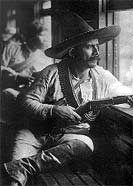
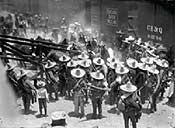
Φωτογραφίες του Agustin Victor Casasola, 1900-1940
Αθήνα, Μουσείο Μπενάκη – Κτήριο οδού Πειραιώς
10/10/2006 - 3/12/2006
Ο Agustin Victor Casasola, γεννήθηκε στην Πόλη του Μεξικού το 1874 και από πολύ μικρός ξεκίνησε να δουλεύει σαν τυπογράφος. Το 1912, ίδρυσε το φωτογραφικό πρακτορείο που το σλόγκαν του ήταν: «Έχω, ή μπορώ να δημιουργήσω τη φωτογραφία που χρειάζεστε». Η συλλογή των φωτογραφιών που συγκέντρωνε και συντηρούσε για δεκαετίες, φυλάσσεται από το 1976 στην Εθνική Φωτογραφική Βιβλιοθήκη του Μεξικού.
Πρόκειται για την πιο σημαντική φωτογραφική συλλογή, που μας επιτρέπει να κατανοήσουμε την ιστορία και την κοινωνία του συγκλονιστικού πρώτου μισού του 20ου αιώνα στο Μεξικό.
Η έκθεση περιλαμβάνει μια επιλογή από 92 φωτογραφίες διαφόρων μεγεθών και πραγματοποιείται στο πλαίσιο του 13ου Διεθνούς Μήνα Φωτογραφίας, 2006.
Την έκθεση έχει επιμεληθεί ο Pablo Ortiz Monasterio, γνωστός φωτογράφος και εκδότης του Μεξικού.
Διοργάνωση:
Canopia, TURNER, CONACULTA INAH, με την υποστήριξη της Πρεσβείας του Μεξικό και σε συνεργασία με το Μουσείο Μπενάκη - Φωτογραφικά Αρχεία)
Χορηγία:
Intralot S.A., Επιχειρηματικό Συμβούλιο Ελλάδoς-Λατινικής Αμερικής, Vernicos Yachts, Olmeca, Corona, IBERIA
Μουσείο Μπενάκη
Posted by...Juanita La Quejica at 11:53 π.μ. 13 comments




